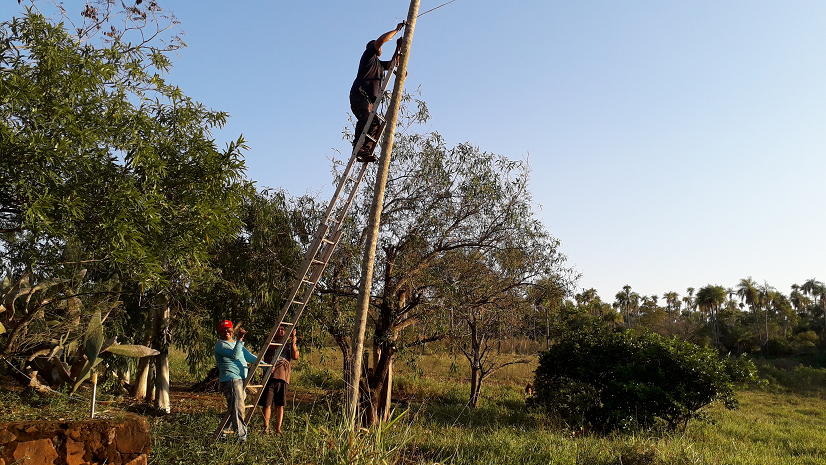The replacing of the posts that bring electricity up from the street to my house was a job that had needed doing for a while.
My house is 100 metres from the street and needs a row of posts to carry the cables. The electric company is responsible for everything street side of the meter and me for everything the other side.
Electric meters in Paraguay are generally placed by the garden gate so they can be read with ease and without disturbing the homeowners. So that leaves me to deal with 100 metres of posts and cables.
To carry the cables over that distance I have a row of four posts. Then from the final one a cable runs across to connect with the house itself.
The current posts had been up for 15 years. The combined effect of weather, insects and woodpeckers had over time caused them to slowly rot and decay.
In fact one had already fallen and for a while had been replaced by a couple of temporary posts. enough to keep the cables off the ground but certainly not enough to keep them at a safe height.
Of the remaining three only one was still fairly solid. The other two swayed alarmingly at the slightest touch. A collision with a cow would probably been enough to send them crashing to the ground.
So enough was enough and it was time they were all replaced.
The posts themselves are the trunks of native trees. They grow straight and slender for many metres before branching out. Their diameter is never much more than 15 cm and that along with how straight they grow makes them ideal as posts.
Although thin the trunks are heavy. The wood is very tough and dense. They are also resistant to rot and so last far longer in the ground than other similar sized trunks would do.
The place to find the posts is with the sellers of building materials. Incredibly none of building suppliers in Piribebuy had one. Quite surprising as such things are always in demand.
So instead posts needed to be sourced from Caacupe. Twice as far away and so charging more than twice as much to deliver.
Even so the delivery still only cost £10. So incontinent more than troublesome.
To do the work I had a small team of three local men. An electrician and two helpers.
The original plan had been to do the work over a couple of days. Dig pits on the first day and then install the posts on another once they had arrived.
That is not quite how things turned out. It always helps to be flexible here.
As it was the work started as planned yesterday morning. A row of deep pits was dug to take the new posts. These were placed a metre or two inside the old posts to give a slightly more direct run to the house and to ensure that the old posts were not knocked over whilst they were being dug.
That I thought was it for the day.
However the posts arrived at lunch time so they decided it would be best to get the job over in one day.
I did not realize the posts had turned up until I saw one being carried up the garden path.
Not keeping money in my house that meant a quick trip into town to get the cash to pay everyone at the end of the day. I arrived five minutes before the bank closed, which was cutting it fairly fine.
By the time I returned the last post was being lowered into its pit and stood upright. A job that took the full muscle power of all the workers.
Next the electric was turned off and cables disconnected from the house.
To get the wires down two of the old posts were toppled with little more than a gentle shove and only one needed climbing.
The two rotten posts were rotten right through at the bottom and had old woodpecker nests in holes as the top.
Once the cables had been retrieved all that remained to do was thread them along the new row of posts. There were several hours left before sunset so little danger of the work not being finished before dark.
One post at a time the cables were raised high in the air and tied on.
To do this the electrician climbed a ladder balanced against the posts carrying the upper cable. While he climbed someone held the ladder and someone else held the cable taught.
No helmets, gloves or safety equipment beyond securing the top of the ladder to the post with a bit of old rope.
That cable was secured firmly in place. Then a rope thrown up so the lower cable could be raised without the electrician having to descend to the ground to collect it.
All firmly tied in place and pulled tight. Then back down the ladder to repeat the process at the next post.
Everything when smoothly. Apart from the occasional bit of ladder wobble there was not a single drama.
After attaching the cables to the fourth pole all that remained was the bring them the final ten metres across the the house.
Here they run through my garden. I had already been up on my ladder cutting branches to clear a wide corridor. Ensuring there were no obstacles in the path. So nothing would entangle the wires now or later when the winds of a storm blew.
Finally then with still a good hour before sundown cables were attached once more to my house. The switch was thrown in the fuse box and the lights came on.
Now once again my electric cables are supported on firm and stable posts. That way they should now stay for another 15 years before again replacements will be needed.


Recent Comments